Production of electricity and heat in 2007
According to Statistics Finland's statistics on production of electricity and heat, electricity produced in Finland amounted to 77.8 terawatt hours (TWh) or billion kilowatt hours (kWh) in 2007. This was one per cent down from the year before. District and industrial heat production stayed on level with the previous year. District heat production amounted to 33.5 TWh and that of industrial heat to 61.7 TWh.
Production of electricity and heat by production mode in 2007
| Electricity | District heat | Industrial heat | Fuels used1) | ||
| TWh | TWh | TWh | PJ | ||
| Separate production of electricity | |||||
| Hydro power | 14.0 | - | - | - | |
| Wind power | 0.2 | - | - | - | |
| Nuclear power | 22.5 | - | - | - | |
| Condensate energy2) | 14.4 | - | - | 137.7 | |
| Total | 51.1 | - | - | 137.7 | |
| Combined heat and power production | 26.8 | 25.4 | 49.4 | 451.6 | |
| Separate heat production | - | 8.1 | 12.3 | 83.9 | |
| Total | 77.8 | 33.5 | 61.7 | 673.2 | |
1) In calculating total primary energy
used, hydro power and wind power are made commensurate with fuels
according to directly obtained electricity (3.6 PJ/TWh).
Total nuclear energy used is calculated at the efficiency ratio of
33 per cent from produced nuclear power (10.91 PJ/TWh).
2) Condensate power includes condensing power plants, shares of condensate electricity of combined heat and power generation plants, and peak gas turbines and similar separate electricity production plants.
Production of electricity
In 2007 electricity production grew by one per cent from the year before. Production of hydro power increased by 24 per cent and that of wind power by 23 per cent. Production of nuclear power increased by 2 per cent from the year before. Production of condensate energy decreased by 18 per cent and the volume of electricity generated with combined heat and power production was 3 per cent down from 2006.
Combined heat and power production remained the most significant mode of electricity generation; it accounted for 34 per cent of the electricity produced. The decrease from the year before was three per cent. Electricity produced with nuclear energy increased by 2 per cent and its proportion of electricity production stood at 29 per cent. Condensate energy decreased by nearly one-fifth, which decreased the proportion of condensate energy of electricity production into 18 per cent. The water year was more favourable than in the past few years, which resulted in a 24 per cent growth in production of hydro power. Consequently, its proportion increased to 18 per cent. Production of wind power increased from the year before; the growth amounted to 23 per cent. The proportion of wind power of total electricity produced remained at 0.2 per cent.
Electricity production by production mode 2007
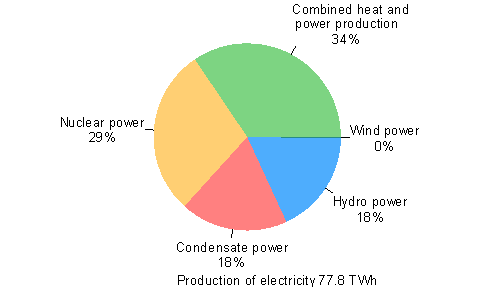
Electricity production by production mode 2000-2007
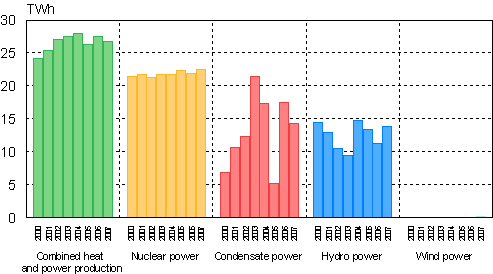
Production of electricity with fuels decreased by 9 per cent as production with nuclear, hydro and wind power increased. The biggest decrease, amounting to 16 per cent, was in electricity produced with wood fuels. Electricity produced with coal and natural gas decreased by 14 per cent. Electricity produced with peat increased by 11 per cent. Electricity produced with peat in condensate power plants grew by particularly much as the volume of electricity produced with other fuels decreased. The reason behind this is likely to be the feed-in tariff system for peat, which entered into force in the beginning of May. It improved the competitive position of peat when compared to hard coal.
Electricity production by energy source 2000-2007
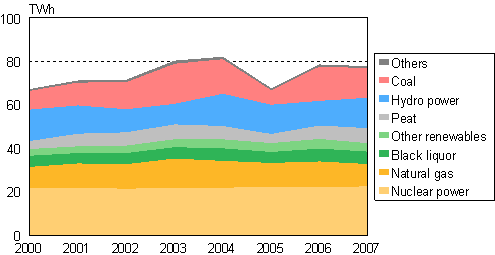
Electricity production by production mode 2000-2007
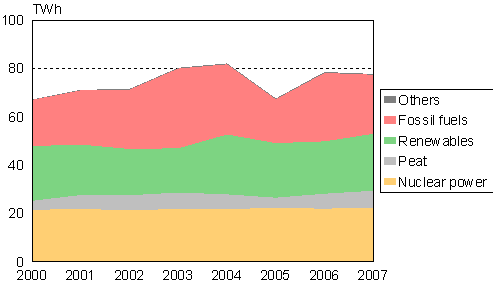
The volume of electricity produced with renewable energy sources grew by 25 per cent in 2007, as production of hydro power, which has been decreasing in the past few years, started to increase. Electricity produced with wood fuels decreased by 16 per cent and that produced with black liquor from the forest industry by 3 per cent. The use of wood fuels fell slightly due to a decrease in production in the wood and paper industry, but the main reason for the fall was the replacement of wood fuels with peat. The volume of electricity produced with wind power and other renewable energy sources was some 20 per cent higher than in the year before.
In the 2000s over one-half of the electricity produced with renewable energy sources has been generated with hydro power; in 2007 its proportion stood at 59 per cent. Electricity produced with black liquor from the forest industry accounted for 24 per cent of the electricity produced with renewable energy sources and that produced with other wood fuels for 14 per cent. Wind power and other renewable energy sources generated 2 per cent of the renewable electricity.
Production of electricity with renewable energy sources 2000-2007
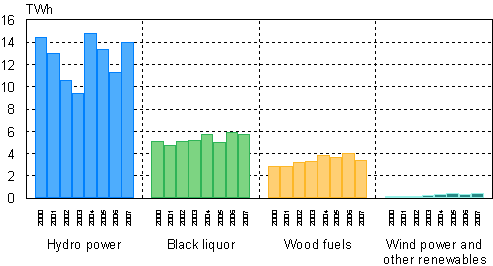
Total consumption of electricity was 90 TWh in 2007. The difference in production and consumption was imported from the Nordic countries, Russia and Estonia. Electricity was also exported from Finland to the Nordic countries and Estonia. Finland is part of the joint Nordic electricity market. In Norway and Sweden the main electricity source is hydro power, which generates electricity with the lowest production costs. Thus electricity produced in the Nordic countries in favourable water years decreases the need to generate more expensive electricity produced with fuels. The structure of electricity production in Finland is influenced also by the capacity of combined production of electricity and heat. The volume of combined production is to a large extent determined by the need of heat. Thus, the production of energy companies is determined by the need of district heat, and in industry it depends to a large extent on the production capacity of manufactured products. In unfavourable water years when energy prices are high also power plants have, within their capabilities, produced extra condensate energy for the Nordic electricity market.
Production of heat
The past few years have been warmer than average, and in 2007 the need of heating energy remained on level with the year before. The volume of heat consumed by industry was also on level with the year before. The volume of combined heat production decreased in both district and industrial heat production and the volume of separate production of heat increased.
Production of heat 2000-2007
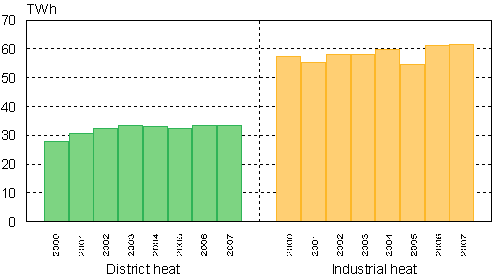
In 2007, seventy-six per cent of district heat was produced with combined heat and power production. The proportion of combined heat and power production of industrial heat was 80 per cent.
The highest volume of district heat was produced by natural gas and coal. Fossil fuels produced 62 per cent, renewable energy sources 14 per cent and peat 21 per cent of district heat.
Production of district heat by fuels 2000-2007
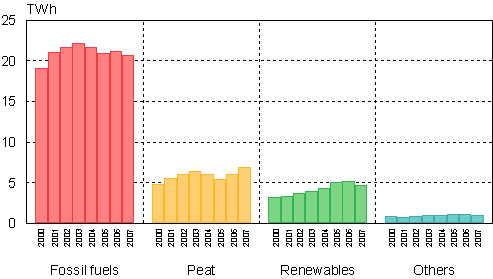
The biggest source of industrial heat, amounting to 43 per cent, was black liquor from the forest industry. Renewable energy sources produced a total of 61 per cent of industrial heat, fossil fuels accounted for 21 per cent and peat for 9 per cent. Among the fossil fuels, natural gas produced the most industrial heat, namely 12 per cent.
Production of industrial heat by fuels 2000-2007
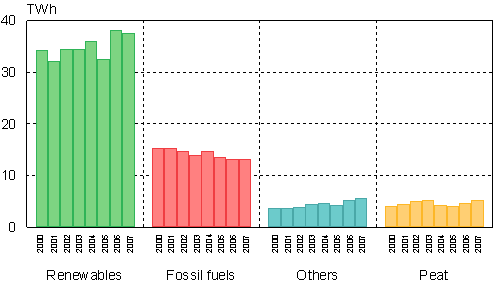
Use of fuels in production of energy
The consumption of fuels in production of electricity and heat decreased by 5 per cent in 2007. Use of coal declined most, by 13 per cent. The use of natural gas, wood fuels and black liquor from forestry decreased as well. By contrast, use of peat and renewable energy sources (i.a. recycled fuels and biogas) increased.
The decrease in the use of fuels was due to the lower demand for domestic fuel-based production of electricity than in the year before. The water situation in the Nordic countries was better in 2007 than in 2006. As a result more electricity was produced domestically and net imports of electricity were higher than in the year before.
Use of coal in electricity and heat production decreased by 13 per cent. Black liquor from the forest industry became the biggest fuel, regardless of the 2 per cent decrease in its use. Black liquor accounted for 23 per cent of fuels, coal for 22 per cent, natural gas for 18 per cent and peat for 15 per cent. The use of natural gas in production of electricity and heat decreased by 10 per cent while the use of peat increased by 10 per cent. Use of other wood fuels declined by 11 per cent. The use of other renewable fuels increased by 15 per cent. Recovered fuels are the biggest fuel among these. After the drop experienced last year, the use of recovered fuels started to increase again as large power plants acquired environmental permits according to the EU Waste Incineration Directive.
The volume of fossil fuels in the production of electricity and heat decreased by 10 per cent, and their proportion of all fuels fell to 45 per cent. The proportion of peat rose to 15 per cent. The proportion of renewable fuels remained at 36 per cent, even though their use decreased by 5 per cent.
Use of fuels in electricity and heat production 2006 and 2007
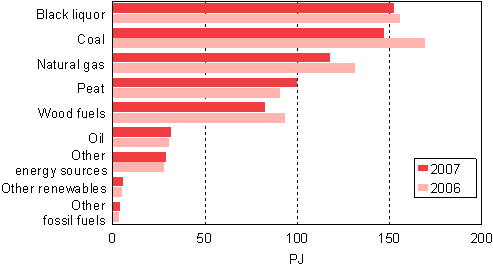
The use of fuels in separate production of electricity decreased by roughly one-fifth in 2007. By far the most used fuel was coal, whose proportion of fuels used was 63 per cent. Use of coal declined by 18 per cent.
The use of fossil fuels in separate production of electricity fell by 25 per cent, and that of renewable fuels by 31 per cent. The use of fossil fuels of all consumed fuels was 68 per cent, and that of renewable fuels was 8 per cent. The use of peat increased by 8 per cent, and its proportion of fuels was 22 per cent.
Use of fuels in separate production of electricity 2006 and 2007
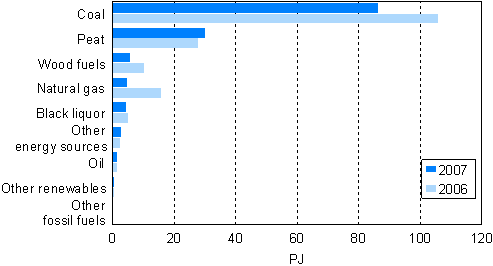
The use of fuels in combined heat and power production decreased by 2 per cent from the year before.
The proportions of different fuels remained almost on level with the previous year. Peat use exceeded that of wood fuels; both had proportions of some 14 per cent. Because of the own energy production of the forest industry, black liquor remains the biggest fuel in combined production. The proportion of black liquor of fuels used is 33 per cent. The proportion of renewable fuels in combined heat and power production fell to 47 per cent in 2007. The use of fossil fuels amounted to 37 per cent and that of peat to 14 per cent.
Information on the division of fuels for combined heat and power production between the production of power and heat is published in the Energy Statistics Yearbook 2008 (out in December).
Use of fuels in combined heat and power production 2006 and 2007
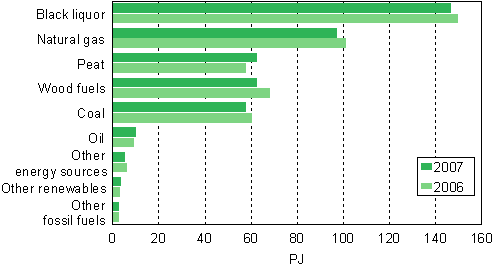 The use
of fuels in separate production of heat increased
by 8 per cent. Unlike in other production modes, the volume of
natural gas and black liquor used in separate production of heat
increased. Natural gas became the third biggest fuel right after
oil. The biggest producer of heat was other energy sources, which
includes i.a. secondary and reaction heat from industry as well as
hydrogen. Of these, the use of secondary heat increased the
most.
The use
of fuels in separate production of heat increased
by 8 per cent. Unlike in other production modes, the volume of
natural gas and black liquor used in separate production of heat
increased. Natural gas became the third biggest fuel right after
oil. The biggest producer of heat was other energy sources, which
includes i.a. secondary and reaction heat from industry as well as
hydrogen. Of these, the use of secondary heat increased the
most.
Of fuels used in the separate production of heat, fossil fuels accounted for 46 per cent and renewable fuels for 21 per cent. The proportion of peat was 8 per cent and that of other energy sources 25 per cent.
The producers of heat included in Statistics Finland's inquiry are included in the data on separate production of heat. The inquiry lacks some of the data on small municipal and industrial heat plants.
Use of fuels in separate heat production 2006 and 2007
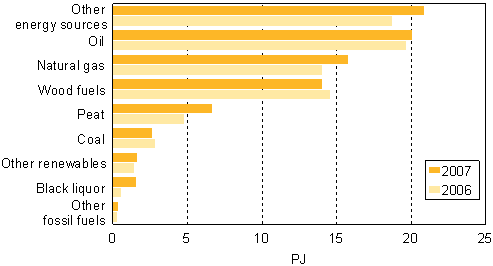
Last updated 26.9.2008
Official Statistics of Finland (OSF):
Production of electricity and heat [e-publication].
ISSN=1798-5099. 2007,
Production of electricity and heat in 2007
. Helsinki: Statistics Finland [referred: 23.12.2025].
Access method: http://stat.fi/til/salatuo/2007/salatuo_2007_2008-09-26_kat_001_en.html

